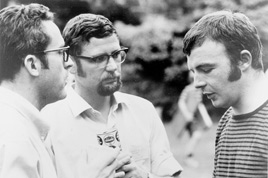|
XXXV: Transcription of Genetic Material 1970 |
|
|

|
From left: Dr. Walter Keller, Dr. Klaus Seifart, Dr. Joseph Sambrook SYMPOSIUM SYNOPSIS LIST OF PARTICIPANTS CONTENTS OF SYMPOSIUM VOLUME PHOTOGRAPHS PUBLISHED VOLUME  |
Transcription of Genetic Material
4–11 June, 1970
Symposium Synopsis
Organizer: James Watson
Advisors: Jim Darnell, Peter Geiduschek, Joe Sambrook and Andrew Travers
The 1966 Symposium had covered the Genetic Code while the 1969 Symposium had reviewed the current state of knowledge about protein synthesis-mRNA, the ribosome and the molecular details of initiation, translocation and elongation, and termination of the growing polypeptide chain. This left a gap—the step DNA molecule in the nucleus and the protein synthesizing mechanism in the cytoplasm—that was filled by the 1970 Symposium.
The Symposium was, again, held at the right moment, for only the year before, Richard Burgess and Andrew Travers had shown that RNA polymerase contained a protein, sigma factor, that directed the enzyme to promoters where transcription of mRNA began. "Suddenly," as Watson wrote in the foreword, "everyone knew that a vast new field was opening up", the molecular dissection of the transcription apparatus. The vigor of the newly-minted field was evident in the size of the meeting—325 participants with 97 papers and 873 pages in the Symposium volume.
Among the many sessions was one on eukaryotic RNA synthesis with several presentations discussing the perplexing heterogeneous nuclear RNA (hnRNA). This RNA varied greatly in size, was larger than needed for the proteins being synthesized and the majority of it turned over on the nucleus. It was believed that mRNA was derived from hnRNA but there was no clear understanding of the relationship between the two forms of RNA. Chamberlin in his summary remarked that "the processing of this nuclear RNA leads to cleavage of the molecules and may generate mRNA" but the full implications of this would have to wait until the 1976 Symposium.
As seemed to happen frequently, some sensational results were worked into the meeting at the last moment. This year it was the report by David Baltimore of the discovery of reverse transcriptase. Howard Temin was unable to attend, but in the event the Symposium volume contained short papers by Mizutani and Temin, as well as by Baltimore. Surprisingly, given the scientific headlines accompanying this discovery—"Central Dogma Overthrown"—Chamberlin's references to this research in his summary were rather muted.
Search images: